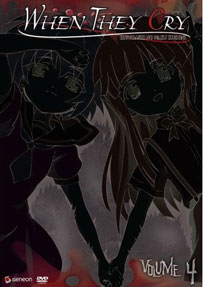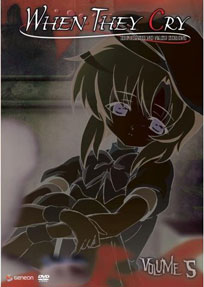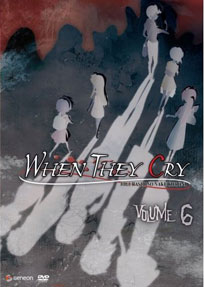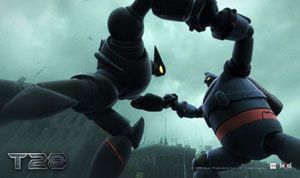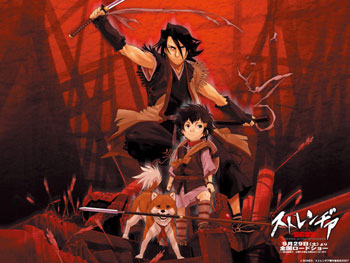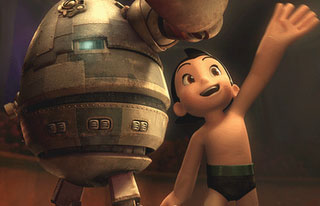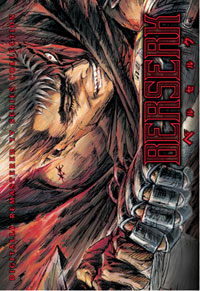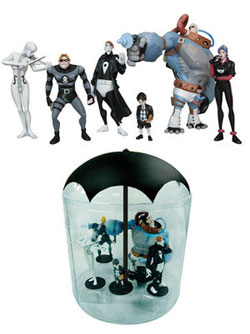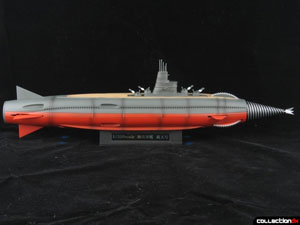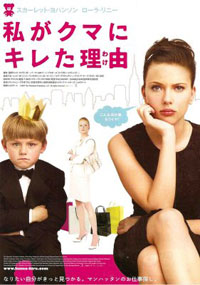 Logo handmade by Bannister
Column by Scott Green
Logo handmade by Bannister
Column by Scott Green
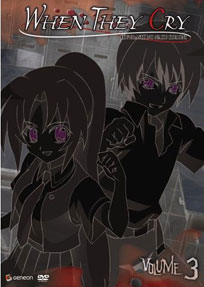
Anime Spotlight: When They Cry Volumes 3-6 Available through FUNimation
When They Cry starts off as a sort of Love Hina relationship comedy crossed with Junji Ito's horror of teenage drama gone terribly awry, Tomie. A young student named Keiichi Maebara moves to a community small enough to fit all of its students into a single school room. Soon, he finds himself install into the inner circle of a group of local girls. There's fanatical appreciator of all things cute Rena Ryuugu. There's slightly older, bossy Mion Sonozaki. There's cunning wild child Satoko Hojo. And, there's quiet, formal Rika Furude. Keiichi quickly learns that his new friends are drawn to competitive endeavors, the losers of which are subjected to physically or psychologically treacherous "punishment games." And soon, Keiichi starts to believe that his friends' games aren't so innocent; that he's alone and endangered in a potentially lethal situation. The live action Battle Royale started with a quick slap in the face. The infamous movie, in which a classroom full of students is forced into a last-person-standing death-match, established its maniacal sadism with a shot of the competition's previous "winner": a normal looking, kindof cute, innocent girl. Despite being covered in blood, she shines a cracked smile. And, the sharpest weapon held by When They Cry falls into that category. The appeal of the anime is the shock of seeing a fancifully animated young girl covered in her own blood or some one else's. It is the cute ideal ("moe" in anime terms) fractured into something frightening, and it's created from pieces that are more recognizably human than the stand-by of a Hello-Kitty like figure with her paws covered in blood.So, after watching a volume or two of this, I had a problem with the implicit attitude behind the horror in When They Cry. I didn't think that "girls are scary" was a healthy message for an anime that sought to speak to moe fans. Beyond the gynophobia, I thought that the fear of remote, rural people was not especially progressive. The section on banned movies in Patrick Macias' Tokyoscope notes that Japanese horror movies have had a prickly relationship with cultural wariness of isolated communities. When They Cry nods to this with references to the history of discrimination against the Burakumin social cast. I was discussing these reservations with a long time anime fan. They retorted that I wasn't understanding When They Cry. They suggested that I taking a reductionist attitude to the series, and it got to the point where they practically accused me of racism. Now that I've seen the whole series (or at least the first season, there's a Higurashi no Naku Koroni Kai TV follow-up, as well as OVA's Higurashi no Naku Koroni Gaiden Nekogoroshi-hen and Higurashi no Naku Koroni Rei, not to mention manga, live action films, and the original games), I agree that I was partially wrong, but also hold to being right in some sense. Regarding my initial impression that When They Cry was operating from an unappealing philosophy, I came to around thinking that the work was more invested in storytelling that capturing a point of view. The When They Cry anime adapted dojin circle 07th Expansion's "sound novel" murder mysteries. These (minimally) interactive fiction games emphasized atmospheric music and sound effects in chronicling the horrors that occurred in the remote community of Hinamizawa in June of 1983. Each game in the series represents a chapter, ending in the Watanagashi (Cotton Drifting) Festival, the murder of a person and the disappearance of another regarded as the curse of the village's divinity Oyashiro. The games and anime start with a series of Question Arcs, ending in mysteries. For example, the initial Spirited Away by the Demon Chapter tracks Keiichi and is limited by his unfamiliarity with the convoluted history of Hinamizawa and relationships between its citizens. As such, when Rena and Mion turn antagonistic against him, there's little on which to hang their motives. Even if you figure that a justification or a least understanding will be granted at a later time, for the moment, the rabid behavior is largely mystifying. Then, When They Cry starts over and takes events down another path. Rather than the same events through a different perspective, it's situation, with a little more understanding and a different destination. Like us, Keiichi seems to have gleamed something from his earlier harrowing. When They Cry will do this three times with Keiichi, then once with a newly introduced police detective who's role will straddle the transition between this Question mode and what's to come. After Spirited Away by the Demon Chapter, Cotton Drifting Chapter, Curse Killing Chapter and Time Wasting Chapter, When They Cry launches into Eye Opening Chapter, which closely adherers to the Cotton Drifting Chapter (the second iteration) from an alternative perspective. In addition to expanding on the information granted in the Question-ing phase, this new, Answer stage begins revealing motives. The appeal here is more a function of intrigue than mystery. When They Cry targets a geek audience, and geeks tend to be obsessive by nature. However, I believe that you have to be consumed by When They Cry before you can piece together a solution. Even then, the answer would have to be as much conjecture as deduction. It's a work the deliberately misleads its audience. Flipping victim and villain is a matter of course, especially when revealing motives for the supposed villains. However, little if any of the provided information is reliable. There are times where the point of view character is lied to, and as far as I can tell, it's impossible to derive the truth until it is revealed. I've read a logical solution matrix that tries to piece out the factors causing a specific outcome for When They Cry, but if I recall it correctly, the information was not entirely presented in this anime series. Suggesting a supernatural element and hiding the rules of the situation as one of its inner most secrets, Higurashi invites participation through conjecture, but it is more of thrill ride than a puzzle. The show here is watching the time bomb count down to when the mayhem is ignited. The count down itself is part of the appeal. Hinamizawa is a fascinatingly populated fish bowl. We get to see the local problems percolating as they contribute to or are exacerbated by the central crime. Then, with the drama heating up, the point of view character becomes frantic enough to dive into the Hinamizawa madness. A number of times, most recently in regards to Gantz, I'm mentioned the debate as to whether watching horror is an exercise in sadism or masochism. I find that the answer depends on the work of horror that you are examining. While there are moments where When They Cry encourages us to feel the rage, confusion or frustration of its point of view characters, the shifting perspective and unreliability also serves to alienate them from us. As such, we wince when graphically depicted violence is inflicted upon these characters in scenes of fingernails being extracted or throats being clawed out, but this is more a reaction to what is happening than concern for the characters. The promise of the spectacle of something horrific is dangled as a carrot at least as much as the promise of a solution being held out. The animation itself is a good hint as to the intended emphasis. The Higurashi games where produced by of dojin circle of contributors who entered into the endeavor more as enthusiasts than as professionals. The games had a rough aesthetic and the anime often follows suit, with effective, but simplistic designs. However, when the anime means to excite our morbid fascination, it starts painting the sky in evocative hues, saturating the tones, applying a particular oil slick filter, and otherwise working to lock in our attention. What distinguishes When They Cry is the knowledge that something invariably forthcoming. So, I was neither quite right nor entirely wrong about the philosophy that When They Cry was emphasizing. However, the point that my critic really nailed was that I was missing a lot of the significance of what When They Cry was presenting. The cult popularity of When They Cry is a testament to the appeal of its juxtaposition of moe cuteness and severe violence, because much of the rest of the creators' intent is not going to entirely connect with North American fans. I have to go back a while to think of a show that trades in Japanese culture to the significant extend that When They Cry does. The one that comes to mind is 1997's Gasaraki, VOTOMS creator Ryosuke Takahashi's post Evangelion, post-Gulf War mecha series. That anime was widely regarded as dry to begin with, but once the it started drawing in Noh and Shinto as tools in examining the subject military-industrial zaibatsu, it entirely befuddled most of the American audience trying to follow it. My ambivalence about how When They Cry was dealing with rural communities turned out to be an aspect of this, but where ever you start examining When They Cry, you find its concepts are deeply rooted in Japanese culture. Little here is floating in the ether of internationalized pop media. To a large extend, a Gurren Lagann giant robot will register the same way to an American audience as it would a Japanese one. Same for a poltergeist in Ghost Hunt, or an Afro Samurai. The same can't be said for what is presented in When They Cry. I'm treading on a thin band of knowledge, so hopefully I don't muddle this... Start with the title When They Cry - Higurashi no Naku Koro ni. While the "they" might seem to refer to all the people hurt repeatedly over the course of the story, the literal translation is "When Cicadas Cry." We have cicadas in America, but the sound that these bugs make during the summer has a more significant implication to a Japanese audience. When an anime plays their buzz in the background, it expects the audience to think of a time and place. Then, there's the setting. Hinamizawa is embroiled in strife with itself and with the outside world due to a proposed dam construction that would flood the community. By setting the story in the heat of the 80's economic boom, the dam becomes part of a larger movement rather than an isolated public works project. The punishment games played by the protagonists? They're intertwined with owarai comedy and the painful/humiliating spectacle of Japanese game shows. While non-Japanese audiences can follow and enjoy When They Cry, there are layers that are not going to be apparent to those non-native viewers. Personally, When They Cry did not hit the right notes for me. In my case, world of cute, damaged people didn't provoke anything. I was intrigued with how it would develop itself, but it was an anime that I always filtered through a critical lens. That said, I can appreciate what it does. I can acknowledge that the bloodletting and mystery have intrigued plenty of North American fans, and that it plays the xylophone over Japanese cultural touchstones.
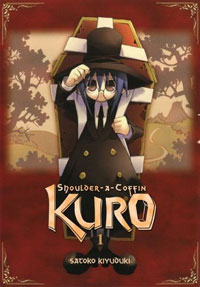
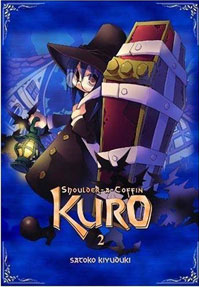
Manga Spotlight: Shoulder-a-Coffin Kuro Volumes 1 and 2 By Satoko Kuyuouki Released by Yen Press
Shoulder-a-Coffin Kuro is a minor key manga, the spirit of which is a marked contrast from the vehemently polarized reactions that it has stirred in North America. On one hand, about.com:Manga named it an "Underappreciated Gem of 2008," while other reviewers have strongly criticized the manga as slight and forgettable. The book itself works in and ambiguity. For most of its first two volumes the impetus for its plot is kept clouded in mystery. More often suggesting a tone rather than hammering a point, it's strange to think of Shoulder-a-Coffin Kuro as a divisive work. The manga's title describes its lead character. Kuro ("black") is an androgynous young woman (there are a few blind men and the elephant style conversations about Kuro in which different participants refer to her by different gender pronouns), dressed in black mortician/vaguely Puritanical garb with a coffin strapped to her back and talking bat Sen and his 999 siblings in tow. Wandering the roads of a Miyazaki/Kino's Journey quasi Europe, she stops in on the manner of a professor of the occult. When he doesn't answer his door after 119 knocks, Kuro and Sen let themselves in, and in the presumably abandoned building's basement they find a pair of ghostly pale young cat-eared girls locked in a cage. The two children, Nijuku and Sanju begin making a game of teleporting in and out of the metal bars, and in moments, Kuro has a pair of ethereal companions serving as the yin to her yang. Chapters of Shoulder-a-Coffin Kuro chronicle the fairytale like encounters of Kuro's travels. For example, Kuro arrives at a community that bustles around a grand cathedral. A desperate looking man hails Kuro as she passes by. Noting that she looks like someone "familiar with unorthodox magic or witchcraft," the man takes Kuro to see his illness stricken daughter. This man explains that the bishop of the church has been unable to help his daughter, but also mentions a witch on the outskirts of town. We, the reader don't see the countenance in question, but the girl's mother mentions "that traveler’s face made the most terrifying expression for a moment." So, Kuro and Sen travel from the town until they see a cottage situated at the top of a Nightmare Before Christmas curled hill. There, they meet a bubbly blonde woman who proves to be the witch, and as a proxy, Kuro heals the ill girl and the relationship between the devout community and their pagan neighbor. In a welcome, unconventional move, Yen Press has published the manga with the opening pages of Shoulder-a-Coffin Kuro's chapters in their original, colored format. In a more distinctively strange move, Satoko Kuyuouki relates the story of the manga through vertically aligned four panel comics strips. North American manga readers may have seen four panel strips (also known as 4koma or yonkoma) before in comedies such as Azumanga Daioh or as humorous supplements in margins or appendices of other manga. In comedies the format applies rhythm to the joke. A situation is presented. It's developed. It reaches a climax. Finally, it concludes. Here's an example from Azumanga Daioh. Panel 1: a girl with outstretched arms yells "oh no! could you get that for us, please?" as a soccer ball bounces towards a lady. Panel 2: the lady is staring at the oncoming ball in preparation. Panel 3: the lady has kicked the soccer ball up, into her own face. Panel 4: the girl mutters "uh, you could've used your hands..." as the lady holds her head moaning "waaaugh." The rhythm of four panel strips is an unusual fit for a non-comedy manga like Shoulder-a-Coffin Kuro. An example of how it works.. Panel 1: a top down shot of Kuro carrying Sanju under her arms, muttering "it suddenly got really heavy..." Panel 2: a head shot reveals that Nijuku is also curled up asleep on top of the coffin, as Kuro continues "Did both of them fall asleep.? They're so selfish." Panel three: A side view body shot of Kuro walking, carrying the girls and explaining "It's been a long time since I walked without anyone to talk to." Panel four: a shot of the forest through which Kuro is walking with word balloons relating "I wonder what would've happened to these two if I had left them behind." The next strip continues that chapter's narrative, but a given strip is its own molecule of the story. The confinement of telling the story through four panel sequences has several effects on Shoulder-a-Coffin Kuro. First, it blocks in tunnel vision to one moment, related without many of the medium's graphical tools. Splash pages can't be done. Insets are difficult. Parallel progressions are possible, but not in the same strip. Instead, we're alone with the characters, or, more specifically, with Kuyuouki's representation of the characters. There's a lot of gazing at Kuyuouki's inky, gothic figures with their darling proportions; and there is a lot of trying to read nuances from their mannerisms, set against visually intense backgrounds. In a comedy, the four panel form gives manga the rhythm of a performance, as if the manga were telling you a joke. In a work like Shoulder-a-Coffin Kuro, the format gives the manga a poetic meter. This isn't to say that Shoulder-a-Coffin Kuro is Shakespeare, but it is fascinating to see how manga reacts to a terse, rigid structure. I'm a proponent of finding out to whom a work of manga intended to speak. A Little Snow Fairy Sugar and Bottle Fairy are both anime/manga concerning cute winged micro-girls in innocent situations. The former is shounen, for boys. The latter is seinen for older, teen+ males. If you're looking to make sense of the subtext of the work in question, it's worth while to know differences like these in target audience. Shoulder-a-Coffin Kuro ran Manga Time Kirara, a seinen publication largely comprised of four panel strips. This is not an anthology that receives much notice among North American manga enthusiasts, so kudos to Yen Press for locating the brilliant, unconventional manga. I'm not saying that Shoulder-a-Coffin Kuro should only be read by seinen's Spike TV demographics, or that that's the only audience who would be interested in reading it. Yen Press' "Teen - LV" rating looks fine to me, and I think both male and female readers will appreciate the manga. However, I also think that like most manga, Shoulder-a-Coffin Kuro shows signs of being shaped by its specific readership. Shoulder-a-Coffin Kuro is often more disquieting than entirely bleak or upsetting. There are certainly fairy tales that place greater emphasis on the harsh punishment inflicted on those who mettle with witches or stray off the right path. In the case of Shoulder-a-Coffin Kuro, what's most disturbing is what's not seen. There's a flashback in which another traveler gives Kuro her hat. When it partially covers her eyes, she remarks "I can only see half of what I usually see." The veteran wanderer informs her "half is just right. If you see the whole world, you'll realize that the world is not full of pretty things." I'm not quite sure of the degree of wrongness in matters such as the relationship between Nijuku and Sanju and the Professor who created them or captured them or something, but there's reason to believe that the coffin on Kuro's back is not the only heavy baggage that this cast carries. What makes me more anxious about the manga is the contrast between what Shoulder-a-Coffin Kuro is saying and who it originally said it too. If Shoulder-a-Coffin Kuro ran in Hana to Yume (home of Fruits Basket) or Nakayoshi (home of Hell Girl), I'd say that the manga was drawing from themes of alienation and fitting them with a complementary goth motif. Except, I don't find that a seinen manga would converse with its audience about alienation through a story like the one in Shoulder-a-Coffin Kuro. Similarly, the manga has more than a preponderance of girls receiving fairy tale punishment for their infractions or those of their communities. Volume two in particular looks at the fate of spoiled princesses several times. I think that Shoulder-a-Coffin Kuro intends for its audience to react to rather than relate to its subjects. This raises the complex subject of moe. If these darling figures were intended to provoke feelings of concern, then the manga is working as intended. Personally, I've always maintained a suspicion of cute seinen anime/manga. One reason is because I feel that people who grew up as geeks producing anime/manga concerned with youthful girls, intended for a geek audience establishes a scary echo-chamber to the exclusion of more inventive works. That's certainly not the case with a singular manga like Shoulder-a-Coffin Kuro. Then, there is the pandering or questionable gender politics of those works. I'm not entirely sure that I'm ready to clear Shoulder-a-Coffin Kuro, or even give it the benefit of the doubt (the fact that Satoko Kuyuouki is a woman does not necessarily increase my confidence; look at Peach-Pit's alien slave manga DearS for a demonstration of atrocious gender politics in a manga created by women). Still, Shoulder-a-Coffin Kuro's haunting tone and inventive use of the four panel format makes the manga relentlessly intriguing.
Aronofsky A No Go
MTV's Splash Page recently looked into the persistent chatter about an adaptation of famed wandering assassin with child in manga Lone Wolf and Cub, directed by Darren Aronofsky (The Wrestler, Pi) From the post: “I’d love to do that. It’s one of [Japan's] great pieces of literature. ” Aronofsky told MTV. “The rights from Japan were never cleared,” Aronofsky related. “They tried for a while. I don’t think it’s getting out of there anytime soon.”
New and Upcoming North American Releases
Via Anime on DVD Viz Media will be releasing the anime OVA series I"s and I"s Pure, based on Katsura Masazaku's romantic comedy manga. The 240 release will retail for $29.98. Anime on DVD reports that Media Blasters a Walmart exclusive version of social fantasy Moribito (reviewed here). The Walmart exclusive is a six disc set that contains the first ten episodes spread across five discs while the sixth disc has a small selection of extras such as clean opening and closings, commercials and a promotional video. The price is under $20 Shout! Factory announced that they will be releasing Dinosaur King: Downtown Showdown on February 3rd, 2009 for $14.99. “The Adventure Begins…” with the next 5 episodes from Season One. When the son of a world-famous paleontologist, along with his friends, finds some mysterious dinosaur cards and a stone slate, he discovers he has the power to bring dinosaurs to life! In fact, whoever controls the cards controls the dinosaurs. Our heroes in the making must ensure the cards, now scattered all over the world, don’t fall into the wrong hands!
New and Upcoming in Japan
Trailers/Previews Tengen Toppa Gurren Lagann: Ragan-hen (Lagann Chapter) - the second compilation movie. Osamu Dezaki's The Tale of Genji Naruto 10th Anniversary
T28?
Imagi, animators of the new Astro Boy are testing interest levels for T28 with a CG sizzle reel for a remote controlled giant robot Tetsujin 28.Creative Director of Imagi Animation Studios Felix Ip also offers Tetsujin 28 openings over the decades On a related note, a reminder that Tetsujin 28 redesigns aren't always for the best
Digital Distribution News
Only Asian media digital distributor Crunchyroll announced that titles from Gonzo are now available via streaming. In addition to free streaming on Crunchyroll, fans will have the option of downloading-to-own and a subscription video-on-demand service. The titles that are launching on Crunchyroll, available to North American users, include CHRNO CRUSADE, KALEIDO STAR, LAST EXILE, and PEACEMAKER KUROGANE. Title Synopses: CHRNO CRUSADE In the 1920's, a gun-toting nun named Sister Rosette Christopher and a boy demon named Chrono are New York's first line of defense against the spirits and devils that haunt the city's streets. As part of an elite convent designed to battle demons, they stalk the streets on their dark mission kill the demons, one ugly beast at a time! KALEIDO STAR High flying circus action on the Kaleido Stage - a thrilling show combining circus and magic acts. Watch Sora, a young girl, follow her extraordinary dream to become the top circus performer - the KALEIDO STAR. Created and directed by Junichi Sato, creator of SAILOR MOON and DOREMI. LAST EXILE In this richly romantic/action adventure fantasy, a young duo unravel an aerial epic. Their adventures lead them into magnificent battles as they struggle to unlock the mysteries that grip their planet in eternal conflict. Behold this stunning display of GONZO's boldest 2D/3D series to date! Directed by Koichi Chigira (Blue Submarine No.6, Full Metal Panic!) and character design by Rrange Murata (Blue Submarine No.6, Sega Saturn Wachenroeder) PEACEMAKER KUROGANE A young boy named Tetsu joins an exclusive samurai force to learn the skills he needs to avenge his father's death. With fierce enthusiasm, he trains his sword skills and grows-up fast in a dark world of conspiracy and death. Along the way, he meets friends and rivals, but nothing deflects his vengeful focus! Tetsu will stop at nothing until his father's murderer is found and killed by his own hand! Japanese animation production studios, Toei Animation Co., Ltd., continues their partnership with Crunchyroll, to provide streaming, subscription and download-to-own options for GALAXY EXPRESS 999 and CAPTAIN HARLOCK. Crunchyroll will also be providing bundle options for each series. Title Synopses: GALAXY EXPRESS 999 In a distant future, Tetsuro is a human boy who wants his body replaced with a robotic one. This is possible, but to do so he has to reach the Immortal Planet onboard the space train Galaxy Express 999. Maetel, a beautiful and mysterious blonde woman dressed in Russian style, joins him in the long journey through space. Every episode sees our heroes arriving in a new planet's space train station. Download-to-own: $1.99/episode CAPTAIN HARLOCK The year is 2977. Mankind has become complacent and stagnant. All work is done by machines, while humans spend all their time on entertainment. But when a mysterious invader from the stars catches Earth unawares, only the legendary space pirate Captain Harlock and the crew of the Arcadia have the will to stand against them. Download-to-own: $1.99/episode Crunchyroll and YA Entertainment (YAE) are working together to stream three English subtitled Korean TV drama series. These YAE titles are among the first Korean TV dramas to appear on Crunchyroll alongside the website's leading collection of licensed anime content online. Title Synopses: ALONE IN LOVE ALONE IN LOVE is a smart contemporary love story that dives into the complex world of love and relationships. The 16 episode series stars Son Ye-jin (SUMMER SCENT, LOVERS CONCERTO and APRIL SNOW) and Karm Woo-Sung (THE KING AND THE CLOWN - the most successful Korean film of all time). FREEZE FREEZE stars Lee Seo-Jin (DAMO, PHOENIX and SHOOT FOR THE STARS) as Joong-Won, a vampire who has spent 350 years trying to forget his lost love. Neither living nor dead, Joong-Won runs a luxurious bar with his friend and fellow vampiress E-Hwa played by Son Tae-Young (YEON GAE SOMUN). SOMEDAY SOMEDAY is a 16 episode Korean TV drama with a touch of animation, telling the story of three people's journey into the crazy world of love. Bae Doo-Na (THE HOST) plays Hana Yamaguchi-a successful young cartoonist. Although she writes romantic comics, she is analytical and pessimistic about love. Nicknamed the "Love Analyzer", Hana sees love as a simple biological response. But when her cartoon is discontinued, she sets off on a journey to discover what love really is.* Via Anime News Network Geneon Entertainment will be distributing anime song including Shakugan no Shana's opening theme song "being" by KOTOKO, Shakugan no Shana Second's opening theme song "Joint" by Mami Kawada, and Black Lagoon's opening theme song "Red Fraction" by MELL on the on Apple's iTunes Store online in 22 countries in North America, Europe, and the Pacific Ocean region. Geneon Entertainment also plans to distribute anime soundtracks, character songs, and other materials on behalf of partner labels on iTunes later. The full-color Survival manga by Golgo 13 manga creator Takao Saito was added the iTunes App Store in December.* FUNimation may be selling digitally anime at retail outlets Event News
Event News
Tickets for the one-night, Thursday, Feb. 5th at 7:30 p.m. local time, screening of Sword of the Stranger are now available at www.FathomEvents.com.This is an English dub of the BONES (“Cowboy Bebop,” “Full Metal Alchemist,” “Soul Eater”) animated samurai movie, scheduled to be released in North America by Bandai Entertainment. Bandai is also promoting the event with a MySpace Page and "Luo-Lang" (movie's antagonist) Facebook page. * The New York Comic Con revealed that the event will be hosting a Summit Entertainment presentation of Astro Boy with footage of the movie Sunday, February 8 - 11:30 AM to 12:30 PM - IGN Theater
The Business
Christopher Butcher's Idiosyncratic Take On The Future of Manga paints a pictures of manga publishers contending with new pressures in the book stores, continuing issues with the comic shop direct market and new possibilities for digital distribution. The ideas are developed in More on Manga in 2009* Japan Probe reports on the growing concern with the shrinking number of animators employed in Japan. Most studios outsource the actual drawing and animation portions of their projects to other Asian countries, a practice that could hurt future development of the industry. Some believe that individuals must spend decades doing animation grunt work before working as directors or story planners. They fear that outsourcing all that manual labor reduces the amount of anime-related jobs in Japan and it could lead to a shortage of Japanese people capable of creating anime masterpieces.* Anime News Network has confirmed that FUNimation has laid off at least two employees in a new reorganization. The company issued a statement We can confirm that FUNimation Entertainment has completed a company-wide restructuring that includes staffing reductions in several departments. "This decision was not taken lightly and thoughtful consideration was given as to how this move would affect our customers, vendors and employees," said Gen Fukunaga, president and CEO of FUNimation Entertainment. "However, we must anticipate and adapt to the current economic climate. This action is expected to streamline our processes as we manage our business for long-term growth." The staff reductions were made to the support infrastructure and does not affect the production or acquisitions of titles. FUNimation will continue to acquire the best titles from Japan and has several strategic alliances and acquisitions yet to announce. Only posts suggest twenty employees were laid off. Parent company Navarre Corporation has filed notice that they have terminated the employment of chief operating officer, Brian Burke "in connection with a previously-announced restructuring and workforce reduction. The company does not intend to seek a replacement for this position in the foreseeable future." A profile of Burke can be read here Other rumors concerning Navarre's future as perculating in finacial boards.* Comipress has gone through Oricon and translated the sales tracking periodicals top manga sales figures Top 10 Series of 2008 Rank - Title - Circulation 1 - One Piece - 5,956,540 2 - Naruto - 4,261,054 3 - 20th Century Boys - 3,710,054 4 - Kateikyo Hitman Reborn! - 3,371,618 5 - Bleach - 3,161,825 6 - Nana - 3,122,146 7 - Soul Eater - 3,076,351 8 - Nodame Cantabile - 2,799,299 9 - Rookies - 2,765,163 10 - Gintama - 2,390,196* Skullknight.net features a bit of an explination has to why Media Blasters' Berserk Complete (Remastered) was delayed from 12/23 to 3/10/09 here with a look at the production process here* ICV2 spoke to Dr. Joachim Kaps, Managing Director of Tokyopop Germany about Kodansha's decision not to renew their licenses We asked about Kodansha’s other licensees in Germany. “Two other publishers in Germany (namely Egmont and [Del Rey sister company] Heyne) have stopped a bunch of series from the Kodansha catalogue during the last year due to low sales,” Kaps told us. “Heyne started a small manga program with titles from Kodansha a few years ago, but seems to be on the way back out of manga at the moment. They have stopped Samurai Deeper Kyo, Life, and some other projects during the last year.” “But I have no idea if the unexpected step is related to that,” Kaps said. “Especially as we had the plan to complete projects we had started in the past.”* Via Anime News Network An Ameba News interview with seiyu (voice actor) Shomu Shirogane has indicated that about 1,600 people who work as seiyu in Japan. Of that number, about 10% work full-time as freelancing seiyu. However, 80% cannot make ends meet with their voice-acting assignments alone, and have to take on part-time jobs elsewhere. The remainder includes actors, idols, and media talents who perform in other fields. Another 80,000 are said to be potential seiyu and people who are applying to be seiyu.* Borders Group appointed Ron Marshall as its new CEO. ICV2 reports that Marshall's past position included managing a private equity firm, and previously turned around the $5 billion food distribution and retail organization Nash Finch Company, and was EVP and CFO during a turnaround of $4 billion supermarket retailer Pathmark Stores. Publishers Weekly talks about the move here* The Wallstreet Journal on Disney's push to capture the market for boys aged 6-14 with their new Disney XD brand.* LA Times looks at Mass Animation's Facebook gambit* Rapid TV News reports that French TV production house Carrere Group, owner of animation business Les Armateurs, has filed for Chapter 11 bankruptcy protection.
Cool Figures News
Yamato USA has posted a YouTube presentation of their Akira figures, from their Fantasy Figure Gallery, inspired by Dorian Cleavenger and sculpted by Plant-jzero Moekichi, The figure, which measures 10.50” x 15.00” with her ornamental staff and themed display base is constructed of over 100 individual pieces and features over 400 paint applications.* Dark Horse has announced of a new figure set depicting the six members of The Umbrella Academy introduced in Apocalypse Suite, as well as a book-and-figure set that includes a hardcover edition of the first collected graphic novel and a 4-inch figure of Vanya, AKA The White Violin. The Umbrella Academy Book and Figure Set features a previously unused cover by Gabriel Bá for the special digest-sized hardcover. The included 4-inch figure depicts Vanya as The White Violin. It is scheduled for release in April 2009 at a suggested retail price of $24.99.The Umbrella Academy Figure Set features the six members of the Academy, sized to scale, with Spaceboy measuring a beastly 5-inches as the largest figure in the set, and The Boy stacking up at a small-but-substantial 2-inches. The set is scheduld to be released May 2009, with a suggested price of $39.99. * Collection DX on... The great Saint Seiya feature series continues with Aries Sion Mighty Muggs Darth Vader Gotengo (aka Atragon)GX-09MA Minerva X Shining Shadow Version Gundam Heavyarms A bootleg of Go Nagai's Kotetsu Jeeg VF-1J with SUPER parts (Hikaru Ichijo TV type) Valkyrie VF-1J Bootleg From the anime sister sight Rei Ayanami and Asuka Langley Soryu mermaid figures Speaking of Eva, Evagelion Snowboarding Suit & Unit-00 Snow Board Figures.com reviews Kotobukiya's Devil May Cry 4 Nero ARTFX Statue Yamato Tandam Twins Leopard "Momo" PVC Figure and offers a first look at ASSEMBLE BORG Released in Japan Matt Alt shows off some Battson Toys * On the custom front... Venture Bros. Dunny My Little Orko Kaneda action figure (Akira)* In other merch news,VIZ Media has announced a new partnership with Zazzle brings about the launch of a new line of J-Pop, manga and anime-inspired apparel, stationery, and other items now available at www.zazzle.com/vizmedia The Zazzle partnership represents VIZ Media’s first foray into the ‘on-demand’ arena and is focused initially on several original (non-licensed) designs. The partnership is the initial phase of a larger projected product rollout with Zazzle that will tentatively include shojo (female)-focused fashion designs and other special designs to come in 2009.
Anime x Games
A trailer for King of Fighters XII is now online. Instead of the 8 vs 8 player, the port will feature 4 vs 4.* Insert Credit reports panoramic cockpit game Gundam Senjou no Kizuna will be ported from the arcade to the Sony PSP.
Non-Anime Animated News
Cartoon Network will be airing an original 30-minute Power Puff Girl on January 19th, along with a 14 hour marathon, to celebrate the show's 10th anniversary. The anime inspired Power Puff Girls in turn inspired the anime series Demashita! Powerpuff Girls Z.* The packaged for direct to DVD animated Wonder Woman film confirms that a Green Latern movie is in the works* AWN reports that the voice cast for the 3-D animated indie feature QUANTUM QUEST, made in conjunction with NASA, has been set including two Captain Kirks (William Shatner and Christ Pine) and two Darth Vaders (James Earl Jones and Hayden Christensen), Neil Armstrong, Samuel L. Jackson, Amanda Peet, Jason Alexander, Sandra Oh, Mark Hamill, Abigail Breslin and Spencer Breslin. Dan St. Pierre and Harry Koor are directing from a script by Koor
Worth Checking Out...
Insight Erica Friedman presents A Day With Media Blasters Sci-Fi Japan has an indepth look at the kaiju film Reigo The Ninja Consultants presents part one of SITACon 2008 Podcasters Unite Speaking of podcasts, if you're interested in 80's ninjas, check out Destroy All Podcasts DX on Blood Reign: Curse of the Yoma and Fast Karate for the Gentleman on Wrath of the Ninja Heisei Democracy lists 10 things that are untranslatable for the English language world Reverse Thieves vs 2008 Colony Drop on Cribbing Ridley Scott For Fun And Profit: Lily C.A.T. and In Defense of Gundam 00 gaijinside on tennis classic Aim for the Ace Serdar | Genji Press on the live action version of yokai-fest Kitaro Invincible Super Blog touches on Bat-Manga! and resurrects the attribution debate ComiPress has rounded up 2008 Year-End Report Round-Up and summarized the year Also, Comiket 75 Coverage Round-Up David Welsh looks forward to 2009 manga The Beat’s Annual Yearend Survey, 2009 edition spoke to OEL creators such as Becky Cloonan and Tania del Rio(who mentions a new Tokyopop title) At Heisei Democracy, Otaku Metaculture: Otaku no Video An incendiary anti-yaoi rant Newsarama spoke to voice actors Yuri Lowenthal and Tara Platt AniPages Daily on Dorvack (1983) and Dancougar (1985) Ashi Pro is an interesting studio that had their own unusual style and way of doing things. I've long been a fan of them if just for the two first shows they entirely on their own: Goshogun (1981) and Minky Momo (1982), classics that both stood out back then for having a sensibility quite different from the other work being done in the rest of the industry. Goshogun brought irony and wit to the giant robot genre, while Minky Momo built on what was achieved in Goshogun and went even further, using the magical girls genre as a springboard for creating parodic, witty, free-for-all fantasy. It was a show with real freedom and variety. The stories in particular were unlike anything out there, covering huge range of material, from sophisticated parodies to serious stories conveyed a heavy message about nuclear war and human suffering. Dorvack and Dancougar were the next two shows they did right afterwards The site also talks manga, specifically Red-Colored Elegy Mathew Brady wasn't too found of Red-Colored Elegy Publishers Weekky's Top 10 Manga for 2008 A look at Naoki Urasawa's (Monster) Billy Bat Otaku USA has online coverage of Manga Classic: Bakune Young Bleach Season Two: The Entry Solty Rei: The Complete Series Seven Stars Fighting God Guyferd Jog considers Product I.G's OVA project Kai Doh Maru LA Weekly on Otaku Art Stars: Anime Conventions Are Breeding A New Generation Of Artists Manga Recon's Manga wishlist Media Claiming Ground presents 2008 in a few Split-seconds Via Erin Finnegan Via Same Hat! Happy New Years from Kazuo Umezu On a related note Shintaro Kago In 2009 New Japanese movie posters at Mecha Mecha MediaPaul Robertson's genkigenki girl Canned Dogs has posted images from Mudazumo naki kaikaku - The Legend of Koizumi, the mahjong with appearences by the former prime minister of Japan, both George Bushes, Putin and more. Also, if you look around online, you can find scans of the Baki the Grappler - Gaia Gaiden, featuring an appearence by Barack Obama New Studio4C Nike Samurai Sentai Shinkenger Artifacts of Anime Fandom AnimeExposure from 1992 Oxygen Destroyer: The Magazine of Japanese Animation Hell anime zine's of the 90's 12 pages of Yen Press' Maximum Ride More from the Chika Umino (Honey and Clover) and Kentarou Miura (Berserk) cross over Stormtrooper Bento Pine Cone Totoro moe Watchmen New Orochi Tshirt From Umezu X Otooto22 Misc Kingdom Hearts continues to show big Japanese Baby Names Umezu love in Publishers Weekly's 2008 staff picks Cat Eyed Boy Kazuo Umezu (Viz) The mysterious Cat Eyed Boy narrates disturbing tales of unrepentant monsters, aliens and eerie forces. Yet Japanese horror master Umezu makes it clear that sometimes ordinary people are the greatest horror of all.—Heidi MacDonald A 20th Anniversary CLAMP fan appreciate project has been launched Matt Alt posts notice that Tokyo based Gaijin can make their mark on film through Yoshiki "Slasher" Takahashi's (Shogun Torture) Tokyo Gore Police DVD extras Precocious Curmudgeon ask the question that confront all Black Jack readers... Pinoko Wrong, but how wrong? Erotic Game Makers In Female Manga Form Reverse Thieves is collecting participants for their Otaku Diaries project A profile of Katie Vedder and her Symphonic Anime Orchestra ikimashou.net returns Ghibli World presents a translation of Hayao Miyazaki’S “A Trip To Tynemouth The wonderful PingMag announced that the site "will be taking an extended hiatus, and will not be updated for the foreseeable future."
For more commentary see the AICN Anime MySpace.


